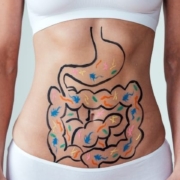Protect Yourself When Taking Antibiotics
We have a bit of a love/hate relationship with bacteria. Many of us have grown up hearing adults warn us about germs – or bacteria. What we, and likely they, didn’t realize is that not all bacteria is bad for us.
In fact, there is a bustling community of bacteria, yeast, and viruses in our guts, and this community plays an important part in our health.
When you have an infection, your doctor is likely to prescribe a course of antibiotics. It usually resolves the infection but may cause gut discomfort or even damage in its wake.
Eva DeAngelis, R.D.N., explains, “When you take antibiotics, the medication doesn’t recognize the good bacteria from the bad. While antibiotics are crucial for removing harmful pathogens when you have an infection, they can also wipe out our beneficial bacteria and hurt our gut microbiota.”
The Benefits Of Probiotics
We have heard that probiotics can help heal the gut. You may even be taking a probiotic now. Research shows that taking a probiotic during a course of antibiotics can help to protect your microbiome.
The microbial community in your gut plays a role in your digestion, mood, and immunity. Having such a significant influence means that protecting that community is important.
Unfortunately, a course of antibiotics can cause your microbiome to remain out of balance for up to two years. An unbalanced microbiome can lead to symptoms like gas, bloating, and diarrhea, or constipation. Up to 35% of people who take antibiotics experience this discomfort.
According to a Journal of Medical Microbiology review, five out of seven studies showed that people who took probiotics during antibiotic treatment experienced fewer gut symptoms.
Choosing The Right Probiotics
There is a wide variety of probiotics available to provide supplemental support for the microbiome. Yet not all are appropriate for preventing digestive discomfort with antibiotic use. Consider these aspects as you make your selection:
Strains Of Bacteria – a healthy gut microbiome has around 1500 different species, but not all probiotic strains provide the right protection against gut irritation.
Kelsey Costa, R.D.N., notes that “both Lactobacillus rhamnosus GG and Saccharomyces boulardii have been found to significantly lower the risk of antibiotic-associated diarrhea.”
Colony-Forming Units (CFUs) – while the type of bacteria you are introducing to your gut is important, the number of bacteria in the supplement also matters. A probiotic dose is measured in colony-forming units, which estimate the number of cells that are healthy enough to reproduce in your gut.
According to a 2017 review, a minimum dosage of 10 colony-forming units per day is needed to reduce the risk of diarrhea and other symptoms related to antibiotic use.
Acid Resistance – simply swallowing the probiotic may not guarantee its benefits. The bacteria in the probiotic must survive the acid in your stomach in order to reach the intestines where they can make a difference.
Quality probiotics are formulated with acid-resistant or extended-release capsules giving the bacteria more of a fighting chance.
Timing Of Probiotics And Antibiotics
When recommending the use of probiotics alongside antibiotics, I always guide my clients in determining when to take them. Antibiotics are designed to kill bacteria, so you wouldn’t take the probiotic at the same time.
Ideally, you would begin the probiotic at the same time as the antibiotic, or within two days. The timing for taking the probiotic is dependent on the antibiotic dosing. In order to space out the probiotic away from the antibiotic dose, consider when during the day you are taking the antibiotic.
For antibiotics taken twice a day – with breakfast and dinner – you could consider taking the probiotic at lunch or at least two hours away from the antibiotic. Some of my clients have felt that they needed to double up on the probiotic, so they took one at midday and another dose at bedtime.
After the course of antibiotics is completed, it is beneficial to continue the probiotic for 1-2 weeks to support restoration of the gut microbiome.
Suggested Products
Do you have questions as to what brands of probiotics would be recommended? Given the wide variety of products offered in stores and online, I’m happy to provide some suggestions:
- Seeking Health Saccharomyces Boulardii – is an effective yeast-based probiotic. If you are sensitive to yeast, or you have a history of yeast infections, consider a spore-based probiotic.
- Pure Encapsulations PureProbiotic – a combination of Lactobacillus and Bifidobacter strains.
- MegaSpore Biotic – a unique all-spore formula that helps to recondition the gut by promoting diversity and maintaining key gut bacteria.
- Renew Life Extra Care Digestive Probiotic – a more robust formula with 12 strains and higher CFUs. This supports those who have repeatedly taken antibiotics or are having digestive challenges before starting the antibiotics.
Helpful Sources
There are numerous online sources from which you can order these probiotics. If you want to explore a dispensary that offers quality products that are responsibly stored and rotated, I can recommend a good one.
It’s a dispensary that I have used and trusted for several years. Email me and I can send you a link to select one of these probiotics and explore other supplements offered.
I don’t recommend frequent use of antibiotics for the sake of protecting the microbiome. Yet, there are times when they may be necessary. I share this information to provide you with reliable protection for your gut while taking the medication.
Wellness is a journey. It is not a straight path but often a very windy road. It can even feel like one step forward and two steps back at times. I encourage you to keep your eye on the goal and make choices each day to pursue wellness.









